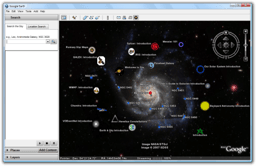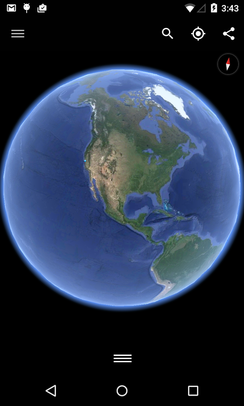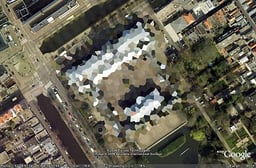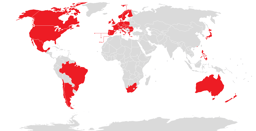Google Earth
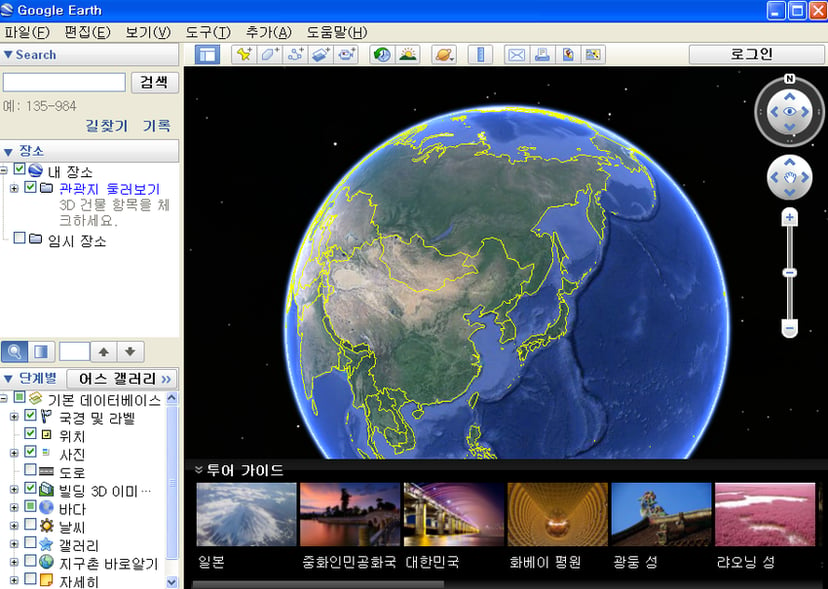
Google Earth

| Map all coordinates using OSM |
|---|
| asKML |
| Export all coordinates asGPX |
| Map all microformatted coordinates |
| Place data as RDF |
Google Earth is a computer program that renders a 3D representation of Earth based on satellite imagery. The program maps the Earth by the superimposition of images obtained from satellite imagery, aerial photography, and GIS data onto a 3D globe, allowing users to see cities and landscapes from various angles. Users can explore the globe by entering addresses and coordinates, or by using a keyboard or mouse. The program can also be downloaded on a smartphone or tablet, using a touch screen or stylus to navigate. Users may use the program to add their own data using Keyhole Markup Language and upload them through various sources, such as forums or blogs. Google Earth is able to show various kinds of images overlaid on the surface of the earth and is also a Web Map Service client.
In addition to Earth navigation, Google Earth provides a series of other tools through the desktop application.
Additional globes for the Moon and Mars are available, as well as a tool for viewing the night sky. A flight simulator game is also included. Other features allow users to view photos from various places uploaded to Panoramio, information provided by Wikipedia on some locations, and Street View imagery. The web-based version of Google Earth also includes Voyager, a feature that periodically adds in-program tours, often presented by scientists and documentarians.
Google Earth has been viewed by some as a threat to privacy and national security, leading to the program being banned in multiple countries. Some countries have requested that certain areas be obscured in Google's satellite images, usually areas containing military facilities.
| Map all coordinates using OSM |
|---|
| asKML |
| Export all coordinates asGPX |
| Map all microformatted coordinates |
| Place data as RDF |
History
Google Earth was originally developed by Keyhole, Inc., a Mountain View-based company founded in 2001. Keyhole, after being spun off from Intrinsic Graphics, received funding from the Central Intelligence Agency's venture capital firm, In-Q-Tel and the National Geospatial-Intelligence Agency, in addition to smaller capital from Nvidia and Sony. Keyhole developed the program under the name Keyhole EarthViewer, and sold the product for uses in fields such as real estate, urban planning, defense, and intelligence. Google acquired the company in 2004, driving public interest in geospatial technologies and applications.
Imagery
Google Earth's imagery is displayed on a digital globe, which displays the planet's surface using a single composited image from a far distance. After zooming in far enough, the imagery transitions into different imagery of the same area with finer detail, which varies in date and time from one area to the next. The imagery is retrieved from satellites or aircraft. Before the launch of NASA and the USGS's Landsat 8 satellite, Google relied partially on imagery from Landsat 7, which suffered from a hardware malfunction that left diagonal gaps in images. In 2013, Google used datamining to remedy the issue, providing what was described as a successor to the Blue Marble image of Earth, with a single large image of the entire planet. This was achieved by combining multiple sets of imagery taken from Landsat 7 to eliminate clouds and diagonal gaps, creating a single "mosaic" image. Google now uses Landsat 8 to provide imagery in a higher quality and with greater frequency.
Imagery resolution ranges from 15 meters of resolution to 15 centimeters.
For much of the Earth, Google Earth uses digital elevation model data collected by NASA's Shuttle Radar Topography Mission. This creates the impression of three-dimensional terrain, even where the imagery is only two-dimensional.
Every image created from Google Earth using satellite data provided by Google Earth is a copyrighted map. Any derivative from Google Earth is made from copyrighted data which, under United States Copyright Law, may not be used except under the licenses Google provides. Google allows non-commercial personal use of the images (e.g. on a personal website or blog) as long as copyrights and attributions are preserved. By contrast, images created with NASA's globe software World Wind use The Blue Marble, Landsat, or USGS imagery, each of which is in the public domain.
In version 5.0, Google introduced Historical Imagery, allowing users to view earlier imagery.
Clicking the clock icon in the toolbar opens a time slider, which marks the time of available imagery from the past. This feature allows for observation of an area's changes over time.
3D imagery
Google Earth shows 3D building models in some cities, including photorealistic 3D imagery. The first 3D buildings in Google Earth were created using 3D modeling applications such as SketchUp and, beginning in 2009, Building Maker, and were uploaded to Google Earth via the 3D Warehouse. In June 2012, Google announced that it would be replacing user-generated 3D buildings with an auto-generated 3D mesh. This would be phased in, starting with select larger cities, with the notable exception of cities such as London and Toronto which required more time to process detailed imagery of their vast number of buildings. The reason given is to have greater uniformity in 3D buildings, and to compete with Nokia Here and Apple Maps, which were already using this technology. The coverage began that year in 21 cities in four countries. By early 2016, 3D imagery had been expanded to hundreds of cities in over 40 countries, including every U.S. state and encompassing every continent except Antarctica.
In 2009, in a collaboration between Google and the Museo del Prado in Madrid, the museum selected 14 of its paintings to be photographed and displayed at the resolution of 14,000 megapixels inside the 3D version of the Prado in Google Earth and Google Maps.
Street View
On April 15, 2008, with version 4.3, Google fully integrated its Street View product into Google Earth. Street View displays 360° panoramic street-level photos of select cities and their surroundings. The photos were taken by cameras mounted on automobiles, can be viewed at different scales and from many angles, and are navigable by arrow icons imposed on them. When Street View was added to Google Maps, on May 25, 2007, five cities were included. It now shows thousands of cities worldwide.
Water and ocean
Introduced in Google Earth 5.0 in 2009, the Google Ocean feature allows users to zoom below the surface of the ocean and view the 3D bathymetry. Supporting over 20 content layers, it contains information from leading scientists and oceanographers. On April 14, 2009, Google added underwater terrain data for the Great Lakes.
In June 2011, Google increased the resolution of some deep ocean floor areas from 1-kilometer grids to 100 meters.
The high-resolution features were developed by oceanographers at Columbia University's Lamont-Doherty Earth Observatory from scientific data collected on research cruises.
The sharper focus is available for about 5 percent of the oceans.
This can be seen in the Hudson off New York City, the Wini Seamount near Hawaii, and the Mendocino Ridge off the U.S Pacific coast.
Outer space
Google Sky
Google Sky is a feature that was introduced in Google Earth 4.2 on August 22, 2007, in a browser-based application on March 13, 2008, and to Android smartphones, with augmented reality features. Google Sky allows users to view stars and other celestial bodies. It was produced by Google through a partnership with the Space Telescope Science Institute (STScI) in Baltimore, the science operations center for the Hubble Space Telescope. Dr. Alberto Conti and his co-developer Dr. Carol Christian of STScI plan to add the public images from 2007, as well as color images of all of the archived data from Hubble's Advanced Camera for Surveys. Newly released Hubble pictures will be added to the Google Sky program as soon as they are issued.
New features such as multi-wavelength data, positions of major satellites and their orbits as well as educational resources will be provided to the Google Earth community and also through Christian and Conti's website for Sky.
Also visible on Sky mode are constellations, stars, galaxies, and animations depicting the planets in their orbits.
A real-time Google Sky mashup of recent astronomical transients, using the VOEvent protocol, is being provided by the VOEventNet collaboration. Other programs similar to Google Sky include Microsoft WorldWide Telescope and Stellarium.
Google Mars
Google Mars is an application within Google Earth that is a version of the program for imagery of the planet Mars.
Google also operates a browser-based version, although the maps are of a much higher resolution within Google Earth, and include 3D terrain, as well as infrared imagery and elevation data. There are also some extremely-high-resolution images from the Mars Reconnaissance Orbiter's HiRISE camera that are of a similar resolution to those of the cities on Earth. Finally, there are many high-resolution panoramic images from various Mars landers, such as the Mars Exploration Rovers, Spirit and Opportunity, that can be viewed in a similar way to Google Street View.
Mars also has a small application found near the face on Mars. It is called Meliza, a robot character the user can speak with.
Google Moon
Originally a browser application, Google Moon is a feature that allows exploration of the moon.
Google brought the feature to Google Earth for the 40th anniversary of the Apollo 11 mission on July 20, 2009. It was announced and demonstrated to a group of invited guests by Google along with Buzz Aldrin at the Newseum in Washington, D.C. Google Moon includes several tours, including one for the Apollo missions, incorporating maps, videos, and Street View-style panoramas, all provided by NASA.
Other features
Google Earth has numerous features which allow the user to learn about specific places.
These are called "layers", and include different forms of media, including photo and video.
Some layers include tours, which guide the user between specific places in a set order.
Layers are created using the Keyhole Markup Language, or KML, which users can also use to create customized layers. Locations can be marked with placemarks and organized in folders; For example, a user can use placemarks to list interesting landmarks around the globe, then provide a description with photos and videos, which can be viewed by clicking on the placemarks while viewing the new layer in the application.
In December 2006, Google Earth added a new integration with Wikipedia and Panoramio. For the Wikipedia layer, entries are scraped for coordinates via the Coord templates. There is also a community-layer from the project Wikipedia-World. More coordinates are used, different types are in the display, and different languages are supported than the built-in Wikipedia layer. The Panoramio layer features pictures uploaded by Panoramio users, placed in Google Earth based off user-provided location data. In addition to flat images, Google Earth also includes a layer for user-submitted panoramic photos, navigable in a similar way to Street View.
Google Earth includes multiple features that allow the user to monitor current events.
In 2007, Google began offering users the ability to monitor traffic data provided by Google Traffic in real time, based on information crowdsourced from the GPS-identified locations of cell phone users.
Flight simulators
Google Earth in Sky Viewing Mode
In Google Earth 4.2, a flight simulator was added to the application. It was originally a hidden feature when introduced in 2007, but starting with 4.3, it was given a labeled option in the menu. In addition to keyboard control, the simulator can be controlled with a mouse or joystick. The flight simulator can be commanded with the keyboard, mouse, or plugged-in joystick. The simulator also runs with animation, allowing objects such as planes to animate while on the simulator.
Another flight simulator, GeoFS, was created under the name GEFS-Online using the Google Earth Plug-in API to operate within a web browser. As of September 1, 2015, the program now uses the open-source program CesiumJS, due to the Google Earth Plug-in being discontinued.
Liquid Galaxy
Liquid Galaxy is a cluster of computers running Google Earth creating an immersive experience. On September 30, 2010, Google made the configuration and schematics for their rigs public, placing code and setup guides on the Liquid Galaxy wiki. Liquid Galaxy has also been used as a panoramic photo viewer using KRpano, as well as a Google Street View viewer using Peruse-a-Rue Peruse-a-Rue is a method for synchronizing multiple Maps API clients.
Versions
Google Earth has been released on macOS, Linux, iOS, and Android. The Linux version began with the version 4 beta of Google Earth, as a native port using the Qt toolkit. The Free Software Foundation consider the development of a free compatible client for Google Earth to be a High Priority Free Software Project. Google Earth was released for Android on February 22, 2010, and on iOS on October 27, 2008. The mobile versions of Google Earth can make use of multi-touch interfaces to move on the globe, zoom or rotate the view, and allow to select the current location. An automotive version of Google Earth was made available in the 2010 Audi A8.
| Version | Release date | Changes |
|---|---|---|
| 1.0 | July 2001 | |
| 1.4 | January 2002 | |
| 1.6 | February 2003 | |
| 1.7.2 | October 2003 | |
| 2.2 | August 2004 | |
| 3.0 | June 2005 |
|
| 4.0 | June 2006 | |
| 4.1 | May 2007 | |
| 4.2 | August 2007 |
|
| 4.3 | April 2008 |
|
| 5.0 | May 2009 |
|
| 5.1 | November 2009 | |
| 5.2 | July 2010 | |
| 6.0 | March 2011 | |
| 6.1 | October 2011 | |
| 6.2 | April 2012 | |
| 7.0 | December 2012 | |
| 7.1 | April 2013 | |
| 7.3 | July 2017 |
|
| 9.0 | April 2017 |
|
Google Earth Pro
One of the lunar landers viewed in Google Moon
Google Earth Pro was originally the business-oriented upgrade to Google Earth, with features such as a movie maker and data importer.
Up until late January 2015, it was available for $399/year, though Google decided to make it free to the public.
Google Earth Pro is currently the standard version of the Google Earth desktop application as of version 7.3.
The Pro version includes add-on software such as:
Movie making.
GIS data importer.
Advanced printing modules.
Radius and area measurements.
Google Earth Pro is available for Windows (NT-based versions), macOS 10.4 or later, and Linux.
Google Earth Plus
Discontinued in December 2008, Google Earth Plus was a paid subscription upgrade to Google Earth that provided customers with the following features, most of which have become available in the free Google Earth.
GPS integration: read tracks and waypoints from a GPS device. A variety of third-party applications have been created which provide this functionality using the basic version of Google Earth by generating KML or KMZ files based on user-specified or user-recorded waypoints.
Higher-resolution printing.
Customer support via email.
Data importer: read address points from CSV files; limited to 100 points/addresses. A feature allowing path and polygon annotations, which can be exported to KML, was formerly only available to Plus users, but was made free in version 4.0.2416.
Higher data download speeds
Google Earth Enterprise
Google Earth Enterprise is designed for use by organizations whose businesses could take advantage of the program's capabilities, for example by having a globe that holds company data available for anyone in that company.
As of March 20, 2015, Google has retired the Google Earth Enterprise product, with support ended March 22, 2017.
Google Earth Enterprise (GEE) allowed developers to build and host their own private maps and 3D globes.
GEE Fusion, GEE Server, and GEE Portable Server source code (470,000+ lines) was published on GitHub under the Apache2 license in March 2017.
Google Earth 9
Google Earth 9 is a version of Google Earth first released on 18 April 2017, having been in development for two years.
The main feature of this update was the launching of a new web version of Google Earth.
This version added the "Voyager" feature, whereby users can view a portal page containing guided tours led by scientists and documentarians.
The version also added an "I'm Feeling Lucky" button, represented by a die, which takes the user to a random location on earth along with showing them a "Knowledge Card" containing a short excerpt from the location's Wikipedia article.
Currently, the web version of Google Earth is only available for Google Chrome.
Google Earth Plug-in
The Google Earth API was a free beta service, allowing users place a version of Google Earth into web pages.
The API enabled sophisticated 3D map applications to be built.
At its unveiling at Google's 2008 I/O developer conference, the company showcased potential applications such as a game where the player controlled a milktruck atop a Google Earth surface.
The Google Earth API has been deprecated as of 15 December 2014 and remained supported until the 15th of December 2015.
Google Chrome ended support for the Netscape Plugin API (which the Google Earth API relies on) by the end of 2016.
Google Earth Outreach
Google Earth Outreach is a charity program, through which Google promotes and donates to various non-profit organizations. Beginning in 2007, donations are often accompanied by layers featured in Google Earth, allowing users to view a non-profit's projects and goals by navigating to certain related locations. Google Earth Outreach offers online training on using Google Earth and Google Maps for public education on issues affecting local regions or the entire globe. In June 2008, training was given to 20 indigenous tribes in the Amazon rainforest, such as the Suruí, to help them preserve their culture and raise awareness for the problem of deforestation.
People who create content for the public benefit sector can create KML files detailing their efforts to the Showcase Gallery, where content is posted in the categories of Global Development, Public Health, Environment and Science, Culture and Education, and Social Services.
The program has been launched in 9 countries: US, UK, France, Italy, Germany, the Netherlands, Spain, Switzerland, and Brazil.
Non-profit organizations featured in Google Earth via the Outreach program include ARKive, the Global Heritage Fund, Greenpeace, WaterAid, and the World Wide Fund for Nature.
Controversy and criticism
The software has been criticized by a number of special interest groups, including national officials, as being an invasion of privacy or posing a threat to national security. The typical argument is that the software provides information about military or other critical installations that could be used by terrorists. Google Earth has been blocked by Google in Iran and Sudan since 2007, due to United States government export restrictions. The program has also been blocked in Morocco since 2006 by Maroc Telecom, a major service provider in the country.
Some citizens may express concerns over aerial information depicting their properties and residences being disseminated freely.
As relatively few jurisdictions actually guarantee the individual's right to privacy, as opposed to the state's right to secrecy, this is an evolving point. Perhaps aware of these critiques, for a time, Google had Area 51 (which is highly visible and easy to find) in Nevada as a default placemark when Google Earth is first installed.
In the academic realm, increasing attention has been devoted to both Google Earth and its place in the development of digital globes.
In particular, the International Journal of Digital Earth features multiple articles evaluating and comparing the development Google Earth and its differences when compared to other professional, scientific, and governmental platforms.
Google Earth's role in the expansion of "earth observing media" has been examined as well.
Leon Gurevitch in particular has examined the role of Google Earth in shaping a shared cultural consciousness regarding climate change and humanity's capacity to treat the earth as an engineerable object.
Gurevitch has described this interface between earth representation in Google Earth and a shared cultural imaginary of geo-engineering as "Google Warming".
Defense
In 2006, one user spotted a large topographical replica in a remote region of China.
The model is a small-scale (1/500) version of the Karakoram Mountain Range, which is under the control of China but claimed by India. When later confirmed as a replica of this region, spectators began entertaining military implications.
In July 2007, it was reported that a new Chinese Navy Jin-class nuclear ballistic missile submarine was photographed at the Xiaopingdao Submarine Base south of Dalian.
Hamas and the al-Aqsa Martyrs' Brigades have reportedly used Google Earth to plan Qassam rocket attacks on Israel from Gaza (See: List of Qassam rocket attacks.)
National security
Former President of India A. P. J. Abdul Kalam expressed concern over the availability of high-resolution pictures of sensitive locations in India. Google subsequently agreed to censor such sites.
The Indian Space Research Organisation said Google Earth poses a security threat to India, and seeks dialogue with Google officials.
The South Korean government expressed concern that the software offers images of the presidential palace and various military installations that could possibly be used by hostile neighbor North Korea.
In 2006, Google Earth began offering detailed images of classified areas in Israel.
The images showed Israel Defense Forces bases, including secret Israeli Air Force facilities, Israel's Arrow missile defense system, military headquarters and Defense Ministry compound in Tel Aviv, a top-secret power station near Ashkelon, and the Negev Nuclear Research Center. Also shown was the alleged headquarters of the Mossad, Israel's foreign intelligence service, whose location is highly classified.
As a result of pressure from the United States government, the residence of the Vice President at Number One Observatory Circle was obscured through pixelization in Google Earth and Google Maps in 2006, but this restriction has since been lifted. The usefulness of this downgrade is questionable, as high-resolution photos and aerial surveys of the property are readily available on the Internet elsewhere. Capitol Hill also used to be pixelized in this way. The Royal Stables in The Hague, Netherlands also used to be pixelized, and are still pixelized at high zoom levels.
The lone surviving gunman involved in the 2008 Mumbai attacks admitted to using Google Earth to familiarise himself with the locations of buildings used in the attacks.
Michael Finton, aka Talib Islam, used Google Earth in planning his attempted September 24, 2009, bombing of the Paul Findley Federal Building and the adjacent offices of Congressman Aaron Schock in Springfield, Illinois.
Other concerns
Operators of the Lucas Heights nuclear reactor in Sydney, New South Wales, Australia asked Google to censor high-resolution pictures of the facility. They later withdrew the request.
In 2009, Google superimposed old woodblock prints of maps from 18th and 19th century Japan over Japan today. These maps marked areas inhabited by the burakumin caste, who were considered "non-humans" for their "dirty" occupations, including leather tanning and butchery. Descendants of members of the burakumin caste still face discrimination today and many Japanese people feared that some would use these areas, labeled etamura (穢多村, translation: "village of an abundance of defilement""), to target current inhabitants of them. These maps are still visible on Google Earth, but with the label removed where necessary.
Late 2000s versions of Google Earth require a software component running in the background that will automatically download and install updates.
Several users expressed concerns that there is not an easy way to disable this updater, as it runs without the permission of the user.
See also
Geoweb
Google Earth Engine
Keyhole Markup Language
Orthophotomap
Planet Google
Virtual globe
Web mapping
- Similar programs
Bhuvan
Bing Maps Platform
Marble
NASA World Wind
Oracle Spatial and Graph
